Part IX:
Porter Films Galore
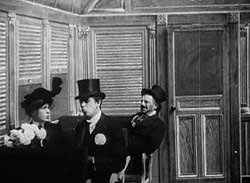 Nervy Nat Kisses the Bride (1904) is a "tramp" comedy which was retitled Weary Willie Kisses the Bride to tie it in with the "funny pages" character of Weary Willie, already adapted to a series of tramp comedy films.
Nervy Nat Kisses the Bride (1904) is a "tramp" comedy which was retitled Weary Willie Kisses the Bride to tie it in with the "funny pages" character of Weary Willie, already adapted to a series of tramp comedy films.
But Nervy Nat didn't really fit Weary Willie's less offending character. Nat's a bum in more ways than one.
In a scant two minutes, the repulsive Nat has in essence three adventures in train station, on the train, & on the tracks.
He first walks into the ticket office at the train station & sees a traveler has fallen asleep over his suitcase. Nat slips up to him & picks the man's pocket, then leaves.
We next see Nervy Nat entering a train car where there's a snappily dressed young married couple doting on one another. When the bride's groom momentarily leaves the car, Nat sneaks up behind, sits down, & with creepy aggresiveness tries to steal a kiss.
Her husband & a couple conductors arrive to force Nat out of the car. We then see an outside view of the train racing down the tracks. As the caboose goes by, Nat gets tossed violently from the rear of the train.
It was of course a dummy tossed from the train, but a nice little trick-film edit has Nat kicking his legs & setting up on the track.
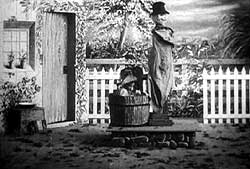 With a stage set up awfully similar to the home of Jack & his mom in Edwin Porter's Jack & the Beanstalk (1902), the amusing one-minute Scarecrow Pump (1904) opens upon a nice country cottage.
With a stage set up awfully similar to the home of Jack & his mom in Edwin Porter's Jack & the Beanstalk (1902), the amusing one-minute Scarecrow Pump (1904) opens upon a nice country cottage.
A lad comes out of the house & goes to the water pump. He paints a face on the top of the pump, gives it a hat, coat, & scarf, & there you have it, a scarecrow pump.
The lad then climbs into a wooden washtub & ducks down to wait & see what happens when a tramp comes by & sees the scarcrow pump.
When a scruffy elderly gent happens by & sees the pump dressed as a scarecrow, he grabs it's handle like a hand & shakes the creature's hand vigorously in greeting, thus accidentally turning the tables on the young prankster in the tub, who gets a dousing of pumped water.
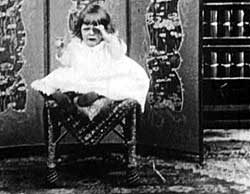 Inspired by Shakespeare's "seven ages of man," Porter's The Seven Ages (1905) depicts in free-standing vignettes the seven ages of romantic love. It was an old thematic idea which, before the advent of the film era, was available in magic lantern sets.
Inspired by Shakespeare's "seven ages of man," Porter's The Seven Ages (1905) depicts in free-standing vignettes the seven ages of romantic love. It was an old thematic idea which, before the advent of the film era, was available in magic lantern sets.
First is "Infancy," & we see a baby crying for his bottle, receiving it from a little girl who hugs & kisses him to cure his tears. Second is "Playmates," when the boy & girl are shown playing under a tree, he trying to steal kisses.
Next they are "Schoolmates." The girl is sitting on a bench outdoors with her school books & the boy joins her, offering her an apple, & she gives him a kiss. Fourth, they are "Lovers," but this sequence does not survive, though it apparently consisted of the young man & woman kissing.
The fifth stage is called "The Soldier." A wife is shown on the stoop of her house watching for husband's return from war. He arrives to a happy embrace & kiss of love & reunion.
Sixth age is "The Judge" when now the couple is maturing with children of their own. Last of all is "Second Childhood" when they enter their dotage together.
Each stage of a lifelong relationship is beautifully arranged visually for a very romantic & sentimental little film that ends with the old couple kissing & laughing, as much in love as when they were children.
There's an unnecessary postscript titled "What Age?" in which an old maid has only a cat to love.
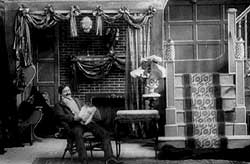 The title of The Strenuous Life; or, Anti-Race Suicide (1904) spoofs a speech made by Theodore Roosevelt soon after his re-election. In a racist declaration that no one today likes to remember, but which was widely quoted at the time, Roosevelt held that white northern European women would have to have more babies if America was to be saved from being overrun by the lesser races.
The title of The Strenuous Life; or, Anti-Race Suicide (1904) spoofs a speech made by Theodore Roosevelt soon after his re-election. In a racist declaration that no one today likes to remember, but which was widely quoted at the time, Roosevelt held that white northern European women would have to have more babies if America was to be saved from being overrun by the lesser races.
Porter's film doesn't criticize the racism but focuses instead on what Roosevelt called "the strenuous life" of those properly white & successful Americans.
The Strenuous Life opens in an office with a secretary taking dictation. Her boss answers a phone then informs his secretary he'll have to leave. She fetches his coat for him, tells him witch hat he should wear, & off he goes by hansome cab through the snowy street.
He meets a physician & back into the handsom cab they go, soon arriving at the office worker's pleasant home. The doctor rushes upstairs -- it's hard to tell why at this point, but in fact the office worker's wife is about to give birth.
The father-to-be goes into another room to wait, read, & worry. Finally a midwife comes downstairs with a baby, & they weight it, & the new father vigorousy shakes the midwife's hand.
She then goes upstairs & soon returns, bringing the father a second child. Cuddling both infants he seems quite happy, but then the midwife dashes downstairs with a third child, & the maid rushes down soonafter with a fourth! It's exactly the "minimum" Roosevelt recommended to defend against "race suicide."
By now the dad is looking horrified, & after recovering from a faint kicks the doctor in the rump & yells at the midwife & maid.
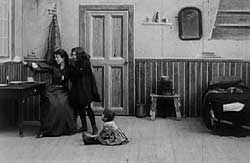 At ten minutes length, long for the era, a wealth of incidents occur in The Kleptomaniac (1905), though the melodramatic plot is simple, with an overt "message."
At ten minutes length, long for the era, a wealth of incidents occur in The Kleptomaniac (1905), though the melodramatic plot is simple, with an overt "message."
A wealthy woman (Aline Boyd) dressed to the nines steals an item of clothing in a department store, either from compulsion or because her life is boring.
She's caught by the department store detectives (Phineas Nairs & Jane Stewart) & soon comes to trial. But with good legal representation & due to her standing in the community, she is forgiven the crime.
A contrasting story is told about an impoverished mother (Ann Egleston) who steals a loaf of bread that was left on the sidewalk outside a store, because her little daughter was starving. She too is caught, arrested, taken to court, but in her case, found guilty, & sent to jail.
This is the beginning of social consciousness in American cinema. After the injustice is perpetrated -- the wealthy permitted to steal for a lark, but the starving & indigent punished for trying to eat -- the blindfolded goddess Justice (Helen Courtney) is shown with her balancing scale. On one side is a loaf of bread. On the other, a bag of gold.
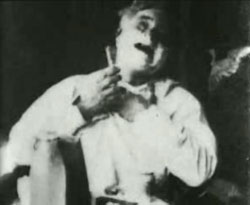 A very slight comedy, A Dull Razor (1900) at about three-quarters of a minute shows us a gent getting well-lathered, accidentally giving himself a mouthful of soap from his shaving brush & spitting up, then getting soap in his eyes.
A very slight comedy, A Dull Razor (1900) at about three-quarters of a minute shows us a gent getting well-lathered, accidentally giving himself a mouthful of soap from his shaving brush & spitting up, then getting soap in his eyes.
He then begins shaving with the titular dull razor. It seems to be going along quite well. He lathers up a second time for a second go at his whiskers, & the film ends.
This is a nice little facial "expression film," though not all that effectively comical. Facial expression films usually starred vaudevillians & were a veritable sub-genre of comedy.
It's odd to think such a trivial film was a popular enough that it was remade by rival film companies, by G. A. Smith later in 1900, & by Sigismund Lubin in 1902.
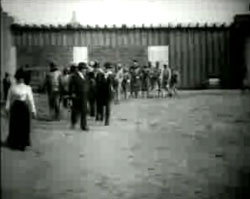 Charleston Chain Gang (1902), filmed in South Carolina, shows plrisoners chained together, against the high wall of a cheaply built building.
Charleston Chain Gang (1902), filmed in South Carolina, shows plrisoners chained together, against the high wall of a cheaply built building.
To the left stands a woman observing the prisoners, who then marches ahead of the guards.
The guards have shotguns & most curiously, are dressed to the nines, perhaps knowing they were going to be filmed. It's odd to think guards inside prisons were dressed as if for Sunday school.
The scene looks as though it could be inside a prison, but the chain gang is actually at the Charleston Exhibition of 1902.
The prisoners are all African American, probably only because the work crews were segregated. There's no implication in this fiolm that black prisoners were selected out for rottenest work, as cleaning up the fairgrounds could be regarded as kind of cushy, if busting rocks into gravel on road crews was the other likely task.
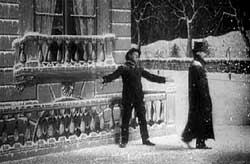 Porter now & then revealed just such progressive attitudes, in films like The Kleptomaniac (1905) which showed the imbalance of justice for the poor vs the wealthy, & The Ex-Convict (1905).
Porter now & then revealed just such progressive attitudes, in films like The Kleptomaniac (1905) which showed the imbalance of justice for the poor vs the wealthy, & The Ex-Convict (1905).
At nine minutes, The Ex-Convict is a condensed adaptation of a one-act stage melodrama by Robert Hilliard & Edwin Holland. One of the sets happens to be the same one used for The Strenuous Life.
We're never informed what the ex-convict did that caused him to serve time. But now he's out, & suffering from the social stigma of having been a jailbird. Porter is completely on the poor sod's side in showing him as a man with a will to do good.
He's a family man with a job in town, but one day at work a police officer spots him & informs his employer about the ex-convicts past. He's fired immediately so must set out in search of another job, meeting prejudice at every turn.
One day he spots a child who has gone into the road. The child's nanny & nearby police officer were useless at protecting the child. The ex-con rushes forward to save her life. He afterward leaves without even waiting for a thank-you.
He returns to his own wife & his bedridden daughter, full of discouragement. He rallies himself & sets out into the snowy evening seeking any opportunity, even if only that of a streetcorner beggar -- or, dare he think it, the opportunity of an unlocked window.
He struggles against desparation but his family's needs overcome his best intentions. He breaks into the house, coincidentally, of the very family whose daughter he'd earlier saved. Sad for him, the father has a gun, holds him at gunpoint & calls the police. He pleads with the man like all criminals who get caught, to no avail.
But then the little girl comes down from upstairs & recognizes the man who saved her life. The break-in is instantly forgiven by the gentleman of means. Our ex-convict will soon have doors opened to him for honest work, & medical attention for his own sick girl.
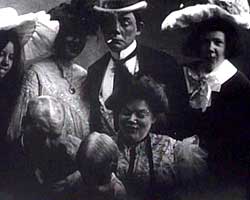 "Do you know this familyi?" asked an opening title card, & we are introduced one by one to the various members of The Whole Dam Family & the Dam Dog (1905).
"Do you know this familyi?" asked an opening title card, & we are introduced one by one to the various members of The Whole Dam Family & the Dam Dog (1905).
These characters originated in a popular postcard series of the time, carictured drawings of one hell of an ugly family, with names like U. B. Dam, Jimmy Dam, LIzzie Dam, Baby Dam & so on.
Edwin S. Porter set out to make this imaginary family come to life. He found actors who can imitate the drawings as absurd, even disgusting people.
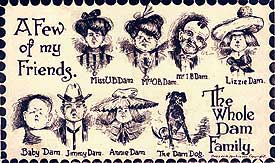 Likely because they originated as cartoon drawings, the title cards are animated, so this little film should also be jotted down as part of animation history. The dog is played by Manny, the world's first dog star of the movies. Likely because they originated as cartoon drawings, the title cards are animated, so this little film should also be jotted down as part of animation history. The dog is played by Manny, the world's first dog star of the movies.
The Dams are shown at the dinner table, the Dam dog refusing to give up one of the chairs to the patriarch without making a to-do about it.
Jimmy Dam smokes at the table & seems to have dyed his whole face with nicotine. As this gross-out family pig out like the horrors they are, the dog returns still peevish that he was denied a seat at the table. Manny grabs an end of the tablecloth, & drags the entire contents onto the floor.
|
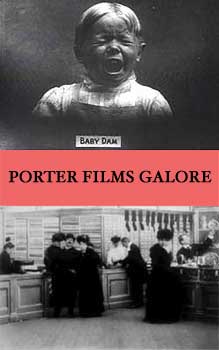









 Likely because they originated as cartoon drawings, the title cards are animated, so this little film should also be jotted down as part of animation history. The dog is played by Manny, the world's first dog star of the movies.
Likely because they originated as cartoon drawings, the title cards are animated, so this little film should also be jotted down as part of animation history. The dog is played by Manny, the world's first dog star of the movies.